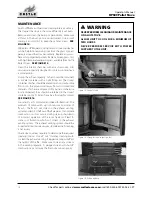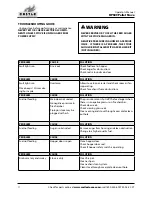
Operator's Manual
HPS09 Pellet Stove
Check for parts online at
www.castlestoves.com
or call 800-345-6007 M-F 8-5 CST
15
outside air connection
Connection from the intake pipe (2” diameter pipe in rear of
stove) to the outside of the house is REQUIRED for mobile
home installation. It is recommended in tightly sealed
homes with exhaust fans such as kitchen or bathroom
fans. This will eliminate poor performance due to negative
pressure.
Only noncombustible pipe 2” (or greater) in diameter is
approved to use for outside air connections (straight or
flexible).
Pvc pipe is not approved and should never
be connected to the stove.
If the air inlet is connected to the outside, it MUST be
terminated with a vertical 90º bend (down) or with a
wind hood. Failure to do so could result in a burn back
during high winds blowing directly up the air inlet during
a simultaneous power failure.
Blockage, excessive length, or extra bends in the air intake
pipe will starve the stove of combustion air. A 90º bend is
equivalent in restriction to approximately 30” of straight
inlet pipe.
mobile home
Installation in a mobile home should be in accordance
with the manufactured home and safety standard.
Department of Housing and Urban Development (HUD)
CITE: 24CFR3280.707 stating this stove must be vented
to the outside. In addition to the standard installation
instructions, the following requirements are mandatory
for installation in a mobile home:
1. The stove must be permanently attached to the
floor.
2. Stove must have an outside air source.
3. Stove must be electrically grounded to the steel chassis
of the mobile home.
4. All vertical chimney vents must have wall supports.
5. All exhaust systems must have a spark arrestor.
6. Check with local building offficials to see if other codes
may apply.
understanding your stove
Your Castle pellet stove utilizes a vertical auger fuel feed
system that is operated by a microprocessor controlled
digital circuit board. The digital circuit board allows the
vertical auger fuel system to run in a timer based, non-
continuous cycle; this cycling allows the auger to run
for a predetermined amount of time. The auger pushes
pellets up a chute located in the hopper. The pellets will
then turn and fall through another chute into the burn
pot. Your stove is equipped with an automatic ignition
system that should ignite the fuel within 3-5 minutes of
pressing the On/Off button . As pellets fill the burnpot
and ignite, outside air is drawn across the fuel and heated
during the combustion process which is then pulled across
the heat exchanger by the exhaust motor or the draft fan.
As the stove reaches operating temperature, room air is
then circulated around the heat exchanger by a room air
blower, distributing warm air into the room.
The amount of heat that is produced by the stove is
proportional to the rate of fuel that is burned. This rate is
controlled by pressing the fuel control button <->.
Because a forced draft pressure is required for the
combustion process inside your stove, it is extremely
important that the exhaust system be properly installed
and maintained. Also, the doors must remain closed while
in operations and the seals on the doors must be properly
maintained.
Warning
do not connect to any air distribution
duct or system.
do not install in a sleePing room.
Caution
the operatIon of exhauSt fanS Such aS
bathroom fans, attic fans, etc. might
starve the Pellet stove of combustible
air creating a negative Pressure in the
room. Provide adequate ventilation
in the room accomPanying the Pellet
stove. if not, the Pressure switch may
shut off oPeration of the Pellet stove.
the struc tur al integrity of the
manufactured home floor, wall, and
ceiling/roof must be maintained.
I










































